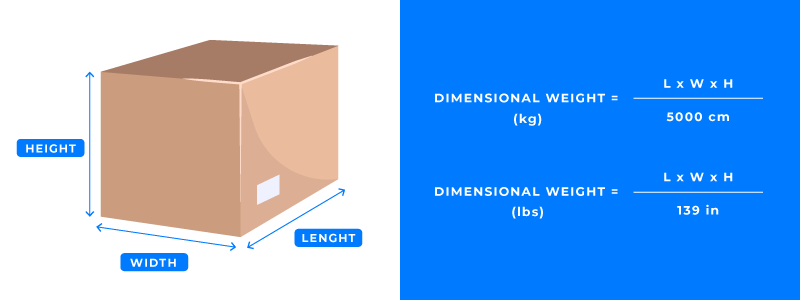How to Calculate Dimensional Weight for Shipping
TL;DR
- Multiply length, width, and height of the package, then divide by the dimensional factor provided by the carrier.
- Common factors: 139 (FedEx, DHL) or 166 (UPS) for inches per pound.
- Use dimensional weight when the package size exceeds its actual weight.
- Couriers use whichever weight is greater (dimensional or actual) to calculate shipping costs.
Dimensional weight is something you will very likely encounter when shipping boxes. Whether you are shipping orders by yourself or through a logistics partner, how to calculate the dimensional weight of shipping boxes is something you need to know.
Book with Eurosender today!
What is the dimensional weight formula?
Dimensional Weight = (Length x Width x Height) ÷ Dimensional factor
When using this formula to calculate the dimensional weight of your shipping boxes make sure that you round up all the numbers to the nearest whole number.
Another detail to be careful of is to use the correct dimensional factor since it will vary depending on the courier you will be using.

What is dimensional weight?
Dimensional weight, also known as DIM, is a pricing technique used by postal and courier services as well as commercial freight forwarders. In short, dimensional weight for shipping boxes is calculated by multiplying length times width times height and dividing by the respective dimensional factor. To better illustrate this, imagine how often people ship their belongings in boxes and packaging materials that are simply too big. These oversized boxes must be packed with extra cushioning to stabilise the contents. These over-packed boxes fill shipping trucks with cubic feet of unneeded corrugated fiberboard, air pillows, and air cushioning.
Therefore, DIM weight pricing can reward customers who eliminate extra, oversized packaging. By increasing the shipment density, we can often pack more products on our trucks and planes.
It’s reasonable to calculate the dimensional weight when shipping boxes since the amount of space on a delivery truck is limited, and the package density is going to determine shipping rates.
How to calculate dimensional weight for shipping boxes?
Follow these 5 steps to find out the dimensional weight when shipping boxes.
- Measure the package. It’s crucial that you provide the correct measurements and not only box sizes indicated by the box manufacturer, as they may not apply. Your measurements should reflect irregularities, bumps, and rounded parts of the package.
- Measure the cubic size by multiplying length x width x height.
- Divide by the dimensional factor. The value of the dimensional factor will be provided by the courier company. However, usually for domestic shipments, the value of the dim divisor varies between 139 and 166. As for international air shipments, it is likely to be 139. DIM divisors are subject to change, so be sure to check out the information from carriers for updates.
- Round up. Since carriers will round up to the nearest whole number, you should do this as well.
- Write down the dimensions and check the shipping rate.
How to get dimensional weight for UPS?
The dimensional factor used by UPS is 166. Thus, the formula goes:
DIM weight = (Length * Width * Height) / 166
Useful tip: With UPS the dimensional weight is not considered if your package is smaller than one cubic foot. However, as with other couriers, USP has a maximum actual weight of a package of 31 kg or 70 pounds. Packages above 31 kg (70 pounds) will not be shipped.
Continue reading about UPS here.
How to get dimensional weight for FedEx?
FedEx’s dimensional factor varies depending on which unit of length and weight is being used in the calculations.
When using inches per pound, the DIM factor is 139:
DIM weight = (Length * Width * Height) / 139
When using centimetres per kilogram, the DIM factor would be 5000:
DIM weight = (Length * Width * Height) / 5000
Useful tip: Make sure that you check the size and weight restrictions of the courier of your choosing. For example, FedEx ships packages up to 150 pounds or 70 kilograms.
Continue reading about FedEx here.
How to get dimensional weight for DHL?
When calculating the dimensional weight for shipping boxes be sure to use the correct formula in terms of units of measure.
When using inches per pound, the DIM factor is 139:
DIM weight = (Length * Width * Height) / 305
When using centimetres per kilogram, the DIM factor would be 5000:
DIM weight = (Length * Width * Height) / 5000
Useful tip: DHL states that shippers should be aware that the shipping weight indicated on the sender’s order confirmation may be based on ground shipping or domestic air shipping from the sender to their hub location.
Continue reading about DHL here.
You may also be interested in:
- Moving heavy items with a van
- Large parcel delivery
- Send parcels of any weight
- Send oddly-shaped items
Dimensional Weight FAQs
What is dim weight pricing?
DIM pricing refers to shipping costs that take into consideration the dimensional weight (DIM) in the overall price of shipping a package. In the case that the DIM weight exceeds the actual weight of the item, the DIM weight is then used to calculate the price instead.
When is DIM needed?
DIM pricing becomes a concern for items that are bulky but not very heavy. In some cases, packaging changes can reduce DIM weight. A good example of this is small electronics that come in large packages. If you are a frequent shipper, the best way to reduce your shipping costs is to negotiate a higher DIM factor with your shipper.
What is billable weight?
Billable weight is a pricing technique used by carriers to calculate shipping rates per package. Billable weight is calculated by considering both dimensional weight (the length, width, and height of a package) and the actual weight of the shipment.
Whichever weight is greater will be used as the billable weight for your shipment, leading to the actual shipping rate.
When do I need to think about dimensional weight?
It’s important to consider dimensional weight when choosing shipping boxes. Bigger boxes will result in bigger DIM weights, and in turn more expensive shipping costs. Consider using the smallest box possible while still ensuring orders are shipping securely.
Disclaimer: The above information has been accumulated through online research and is subject to change at the discretion of the courier companies. Make sure you conduct further research or talk to the courier company directly for the most accurate information.
Are you ready to start shipping?
Book with Eurosender today!
About the author






